Standard [CURRENT]
ASTM D 1452/D 1452M:2025
Standard Practice for Soil Exploration and Sampling by Auger Borings
- German title
- Bodenuntersuchung und Probenahme mittels Schappe
- Publication date
- 2025
- Original language
- English
- Pages
- 7
- Publication date
- 2025
- Original language
- English
- Pages
- 7
- DOI
- https://dx.doi.org/10.1520/D1452_D1452M-25
Product information on this site:
Quick delivery via download or delivery service
Buy securely with a credit card or pay upon receipt of invoice
All transactions are encrypted
Short description
1.1 This practice covers equipment and procedures for the use of earth augers in shallow depth geotechnical exploration. This practice does not apply to hollow-stem augers. Uses of hollow-stem auger drilling methods for geotechnical exploration are addressed in Practice D6151/D6151M . Samples recovered from this standard are considered as belonging to Group A or B in accordance with D4220/D4220M . The samples are disturbed and can generally be used for classification testing ( D2487 , D2488 ), determination of compaction characteristics ( D698 , D1557 ), or any other standard that requires disturbed bulk samples. For obtaining intact samples use of thin-walled sample tubes ( D1587/D1587M ) in conjunction with fluid rotary drilling ( D5783 ) or hollow-stem augers ( D6151/D6151M ) may be considered. 1.2 This practice does not include considerations for geoenvironmental site characteristics and installation of monitoring wells which are discussed in Guides D5783 and D5784/D5784M . 1.3 This practice does not include considerations for collecting surface and subsurface soil and contaminated media samples for chemical analysis using hand-operated bucket augers (referred to as barrel augers in 5.1.4 of this practice) as described in Practice D6907 . 1.4 Units- The values stated in either inch-pound units or SI units presented in brackets are to be regarded separately as standard. The values stated in each system may not be exact equivalents; therefore, each system shall be used independently of the other. Combining values from the two systems may result in non-conformance with the standard. 1.5 All observed and calculated values shall conform to the guidelines for significant digits and rounding established in Practice D6026 unless superseded by this method. 1.6 This standard does not purport to address all of the safety concerns, if any, associated with its use. It is the responsibility of the user of this standard to establish appropriate safety, health, and environmental practices and determine the applicability of regulatory limitations prior to use. 1.7 This practice offers a set of instructions for performing one or more specific operations. This practice cannot replace education or experience and should be used in conjunction with professional judgment. Not all aspects of this practice may be applicable in all circumstances. This practice is not intended to represent or replace the standard of care by which the adequacy of a given professional service must be judged, nor should this document be applied without consideration of a project's many unique aspects. The word "Standard" in the title of this document means only that the document has been approved through the ASTM consensus process. 1.8 This international standard was developed in accordance with internationally recognized principles on standardization established in the Decision on Principles for the Development of International Standards, Guides and Recommendations issued by the World Trade Organization Technical Barriers to Trade (TBT) Committee.
ICS
93.020
DOI
https://dx.doi.org/10.1520/D1452_D1452M-25
Also available in
Loading recommended items...
Loading recommended items...
Loading recommended items...
Loading recommended items...

